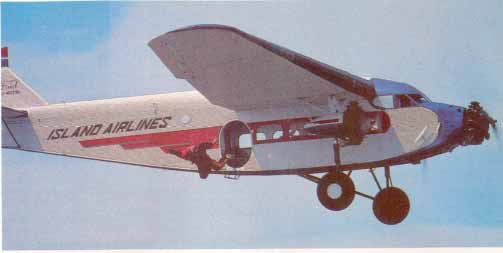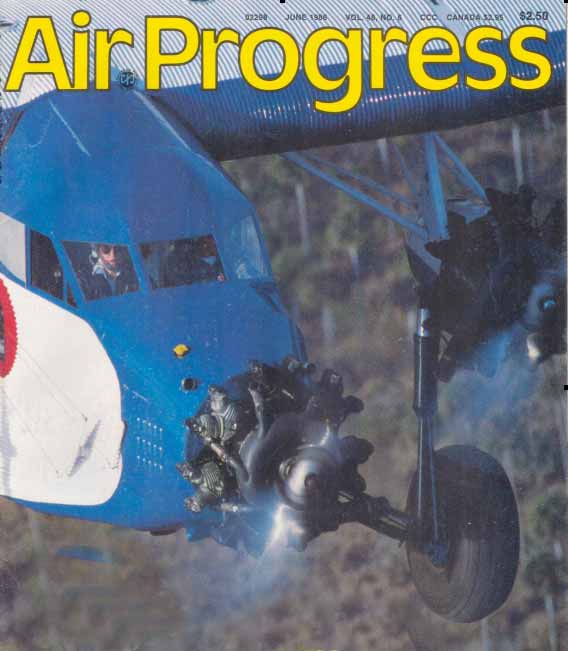PAGE TWO
 |
No that's not a dissatisfied
customer leaving the airplane. All the time we were working with
the airplane, they were flying a non-stop string of jumpers. |
"I had been flying Lears and MU-2s all over the
country hauling 'freight and checks and I was about burned out. I was
tired of flying all night, every night, so, when Al asked me if I'd
like to barnstorm the Ford, I couldn't get packed fast enough."
We caught up with Ed Rusch and his barnstorming Ford almost by accident.
Cruising up and down the airshow line at the 1986 Valiant Air Command
Warbird show in Titusville, Florida, we came across the Ford—looking
terribly out of place—at one end of the ramp. I stumbled out
of the car and found myself in an instant conversation with Ed. Although
we were total strangers, my interest in his airplane was all that was
needed to get things started on a friendly note. Although Ed looks
like the type that is slow to anger, I got the feeling that all it
would take is a few disparaging remarks about the Ford to bring him
to an instant boil. Even then, however, the only outward indication
would be the subtle sound of his clenched teeth snipping the end off
his cigar.
 |
It comes off the ground in
an absolutely level attitude. |
Rusch and the Ford were only visiting the show for the day, since
they had taken up semi-permanent residence at Dunn Air Park on the
north side of Titusville. After several months of hopping
about the country, they had decided to try working the local tourist
trade and they may still be camped there today.
Early the next morning I found myself strapping into the right seat,
while Ed played stewardess, ticket taker and captain in the main (and
only) cabin. Letting my eyes roam around inside the airplane I had
to grin just a little: As an example of aeronautical design the 4-AT-B
is certainly a fine bridge. Everywhere you looked healthy bits of aluminum
angle were riveted to another healthy chunk of aluminum. The massive
main spar ran through the cabin, decreasing headroom by nearly two
feet but providing the forerunner of overhead baggage bins, as that
was where you stowed your bags. Leaning forward and looking down the
leading edge, the rolled ribs in the skin, which formed an exoskeleton
betrayed themselves as an uneven collection of sixty-year-old dents
and patches.
The panel was archaic, as you'd expect, but impressively simple, which
you might not expect. However, when you consider that the three J-6
Wrights (230 hp each) have fixed pitch props, that eliminates the need
for manifold pressure gauges and prop controls.
Remember the solenoid buttons that stuck out of the floor of old Ford
trucks? You turned the key and mashed the button with your foot and
the flathead V-8 sprang into life. Ditto the 4-AT-B. Three typically
Ford starter solenoids poked up between the two sets of rudder pedals.
Mash one, count two or three blades, and that particular engine was
running. Like we said, no muss, no fuss.
AS A SINGLE PILOT OPERATION (VFR, OLD REGS, remember?), doing the run
up was about the most complicated part of the flight and this was only
because of the brakes. The brake is a hip-high lever poking up between
the two seats. A true "Johnson Bar," you pull back for both
brakes, left for left, etc. Which is fine, but it has no lock. So,
in doing the run up, when solo, you have to cross one leg over in front
of the bar and push backward with your thigh to keep the airplane in
one spot. Ed motioned for me to follow him through while he made the
first takeoff. I glanced back ('way back) at the ailerons to make sure
they were centered and mentally made a note as to the position of the
control wheel spokes, when centered.
The tailwheel is a full swivel job so throttles, rudder and Johnson
Bar got us out to the center of the relatively narrow (for a Ford)
runway and Ed moved the throttles to the stops in one smooth motion.
Then, without waiting even a second, he straightened out his arm, two
arms actually, and pushed the wheel full forward. We were barely moving
fast enough for the airspeed to be two digits and the tail staggered
into the air giving an absolutely unobstructed view of the runway.
With only 690 horses on a 10,000-pound load, you wouldn't expect it
to leap off the ground. And it didn't. But, the Ford still surprised
me when the plane floated, literally floated off the ground in a nearly
level attitude. I glanced at the ASI and it read 60 mph! Not bad, considering
we were hauling something like eight people back in the tourist class
section. Later in the day, we followed Ed with our Seneca. He was carrying
about a dozen skydivers up to 4000 feet and it was all we could do
to keep up with him in climb. So much for progress!
GO TO NEXT PAGE
|

